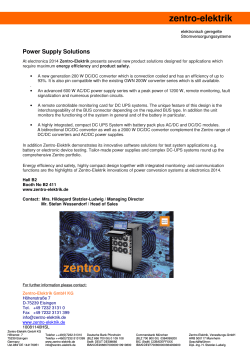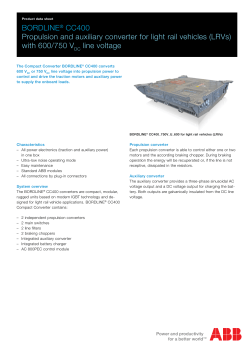
Document 411124
SSRG International Journal of Electrical and Electronics Engineering (SSRG-IJEEE) – volume 1 Issue 9 –November 2014 An Effective Direct Power Control Method for Matrix Converter-Based Unified Power-Flow Controllers in Wind Energy System Vadapally anusha Prasad*1, maraboina santhosh*2 M-Tech Student Department of EEE, VBIT, Aushapur, Ghatkesar, R.R (Dt), Telangana, India. Assistant Professor, Department of EEE, VBIT, Aushapur, Ghatkesar, R.R (Dt), Telangana, India. ABSTRACT This paper presents a Direct Power Control Method for three phase matrix converters operating as a unified power flow controller (UPFC) in Wind energy systems. The MC (Matrix Converter) allows the direct AC/AC power conversion without dc from wind generators. Due to the size of the designed UPFC is reduced and power capacitors losses, with high reliability. This direct power control (DPC) is established for MC-UPFC is for dynamic model with input filters. The result of line active and reactive power together with ac supply reactive power it can be use directly controlled by selecting an appropriate matrix converter switching state assuring good steady-state and dynamic responses. The simulation results of DPC controllers for MC-UPFC show decoupled active and reactive power control and fast response times. Compared to an MC-UPFC using active and reactive power linear controllers based on a modified high-frequency PWM modulator the experimental results of the advanced DPC-MC guarantee faster responses without overshoot and no steady-state error to presenting no cross-coupling in dynamic and steady-state responses. Key words: DPC, UPFC, Matrix Converter. I. INTRODUCTION Electric power flow through an alternating current transmission line is a function of the line impedance, the magnitudes of the sending-end and receiving-end voltages, and the phase angle between these voltages. Essentially, the power flow is dependent on the voltage across the line impedance. Electricity market deregulation, together with growing economic, environmental, and social concerns, has increased the difficulty to burn fossil fuels, and to obtain new licenses to build transmission lines (rights-of-way) and high power facilities. This situation started the growth of decentralized electricity generation (using renewable energy resources). Unified power-flow controllers (UPFC) enable the operation of power transmission networks near their maximum ratings, by enforcing power flow through well-defined lines ISSN: 2348 – 8379 [2]–[4]. These days, UPFCs are one of the most versatile and powerful flexible ac transmission systems (FACTS) devices. The existence of a dc capacitor bank originates additional losses, decreases the converter lifetime, and increases its weight, cost, and volume. In the last few decades, an increasing interest in new converter types, capable of performing the same functions but with reduced storage needs, has arisen [10]–[12]. These converters are capable of performing the same ac/ac conversion, allowing bidirectional power flow, guaranteeing near sinusoidal input and output currents, voltages with variable amplitude, and adjustable power factor [13]– [14]. These minimum energy storage ac/ac converters have the capability to allow independent reactive control on the UPFC shunt and series converter sides, while guaranteeing that the active power exchanged on the UPFC series connection is always supplied/absorbed by the shunt connection. Conventional UPFC controllers do not guarantee robustness [6]–[8] and [11], [12]. In [10], the dependence of the matrix converter output voltage on the modulation coefficient was investigated, concluding that MC-UPFC is able to control the full range of power flow. Recent nonlinear approaches [5] enabled better tuning of PI controller parameters. Still, there is room to further improve the dynamic response of UPFCs, using nonlinear robust controllers. II. RELATED WORK A simplified power transmission network using the proposed matrix converter UPFC is presented in Fig. 1, Fig. 2 shows the simplified three-phase equivalent circuit of the matrix UPFC transmission system model. For system modelling, the power sources and the coupling transformers are all considered ideal. Also, the matrix converter is considered ideal and represented as a controllable voltage source, with amplitude __ and phase_. In the equivalent circuit,___ is the load bus voltage; The DPC-MC controller will treat the simplified elements as disturbances. www.internationaljournalssrg.org Page 53 SSRG International Journal of Electrical and Electronics Engineering (SSRG-IJEEE) – volume 1 Issue 9 –November 2014 three output phases directly to any one of the three input phases. The three-phase (lCr) input filter is required to re-establish a voltage-source boundary to the matrix converter, enabling smooth input currents. Fig 1: Transmission network with matrix converter UPFC. Where __ and __ are, respectively, the sending-end and receiving-end sinusoidal voltages of the__ and __generators feeding load_ . The matrix converter is connected to transmission line 2, represented as a series inductance with series resistance (_ and__), through coupling transformers _ and_. Fig 2: Three-phase equivalent circuit of the matrix UPFC and transmission line. Considering a symmetrical and balanced three-phase system and applying Kirchhoff laws to the threephase equivalent circuit (Fig. 2), the ac line currents are obtained in dq coordinates. Matrix Converter Output Voltages and Input Currents A diagram of the UPFC system (Fig. 3) includes the threephase shunt input transformer (with windings Ta, Tb, Tc), the three-phase series output transformer (with windings TA, TB, TC ) and the three-phase matrix converter, represented as an array of nine bidirectional switches Skj with turn-on and turnoff capability, allowing the connection of each one of ISSN: 2348 – 8379 Fig 3: Transmission network with matrix converter UPFC. Applying dq coordinates to the input filter state variables presented in Fig. 3 and neglecting the effects of the damping resistors, the following equations are obtained: III. PROPOSED METHOD In addition, the matrix converter UPFC can be controlled to ensure a minimum or a certain desired reactive power at the matrix converter input. Similar to the previous considerations, since the voltage source input filter (Fig. 3) dynamics (6) has a strong relative degree of two [25], then a suitable sliding surface ___ _ __ , !_ (19) will be a linear combination of the desired reactive power error __ _ _____ " __ and its first order time derivative. The time derivative can be approximated by a discrete time difference, as #__ has been chosen to obtain a suitable switching frequency, since as stated before, this sliding. The sliding mode is reached when vectors applied to the converter have the necessary $_ current amplitude to satisfy stability conditions, such as (15). Therefore, to choose the most adequate vector in the chosen dq www.internationaljournalssrg.org Page 54 SSRG International Journal of Electrical and Electronics Engineering (SSRG-IJEEE) – volume 1 Issue 9 –November 2014 reference frame, it is necessary to know the output currents location since the $_ input current depends on the output currents (Table I). Considering that the dq -axis location is synchronous with the Via input voltage (i.e., reference frame depends on the Via input voltage location), the sign of the matrix reactive power Qi can be determined by knowing the location of the input voltages and the location of the output currents Fig.5. Active and reactive power response and line currents for a P and Q step IV. SIMULATION RESULTS The performance of the proposed direct control system was evaluated with a detailed simulation model using the MATLAB/SIMULINK SIMPOWERSYSTEMS to represent the matrix converter, transformers, sources and transmission lines, and SIMULINK blocks to simulate the control system. Ideal switches were considered to simulate matrix converter semiconductors minimizing simulation times. CONCLUSION Fig.4. Modeling circuit of the three-phase matrix converter operating as a UPFC with direct power control. ISSN: 2348 – 8379 The model simulation results are shows that the active and reactive power flows can be controlled by using advanced Direct Power Controller. This simulation results are shown no steady state error, and fast response times, and thus getting expected performance of the presented nonlinear DPC methodology. This paper presents a DPC-MC results were compared to both linear active and reactive power controllers using high frequency PWM modulator. Further the PI controller takes longer times to compute the proposed method. www.internationaljournalssrg.org Page 55 SSRG International Journal of Electrical and Electronics Engineering (SSRG-IJEEE) – volume 1 Issue 9 –November 2014 REFERENCES [1] N. Hingorani and L. Gyugyi, Understanding FACTS— Concepts and Technology of Flexible AC Transmission Systems. Piscataway, NJ: IEEE Press/Wiley, 2000. [2] L. Gyugyi, “Unified power flow control concept for flexible AC transmission systems,” Proc. Inst. Elect. Eng. C, vol. 139, no. 4, Jul. 1992. [3] L. Gyugyi, C. Schauder, S. Williams, T. Rietman, D. Torgerson, and A. Edris, “The unified power flow controller: A new approach to power transmission control,” IEEE Trans. Power Del., vol. 10, no. 2, pp. 1085–1097, Apr. 1995. [4] C. Schauder, L. Gyugyi, M. Lund, D. Hamai, T. Rietman, D. Torgerson, and A. Edris, “Operation of the unified power flow controller (UPFC) under practical constraints,” IEEE Trans. Power Del., vol. 13, no. 2, pp. 630–639, Apr. 1998. [5] T. Ma, “P-Q decoupled control schemes using fuzzy neural networks for the unified power flow controller,” in Electr. Power Energy Syst.. New York: Elsevier, Dec. 2007, vol. 29, pp. 748– 748. [6] L. Liu, P. Zhu, Y. Kang, and J. Chen, “Power-flow control performance analysis of a unified power-flow controller in a novel control scheme,” IEEE Trans.Power Del., vol. 22, no. 3, pp. 1613– 1619, Jul. 2007. [7] F. Gao and M. Iravani, “Dynamic model of a space vector modulated matrix converter,” IEEE Trans. Power Del., vol. 22, no. 3, pp. 1696–1750, Jul. 2007. [8] B. Geethalakshmi and P. Dananjayan, “Investigation of performance of UPFC without DC link capacitor,” in Elect. Power Energy Res.. New York: Elsevier, 2008, pp. 284–294, 736-746. [9] X. Jiang, X. Fang, J. Chow, A. Edris, E. Uzunovic, M. Parisi, and L. Hopkins, “A novel approach for modeling voltage-sourced converterbased FACTS controllers,” IEEE Trans. Power Del., vol. 23, no. 4, pp. 2591–2598, Oct. 2008. [10] R. Strzelecki, A. Noculak, H. Tunia, and K. Sozanski, “UPFC with matrix converter,” presented at the EPE Conf., Graz, Austria, Sep. 2001. ISSN: 2348 – 8379 www.internationaljournalssrg.org Page 56
© Copyright 2025














